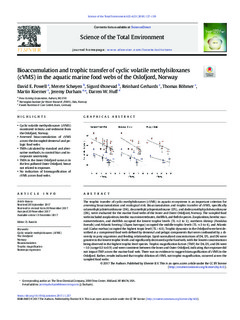Bioaccumulation and trophic transfer of cyclic volatile methylsiloxanes (cVMS) in the aquatic marine food webs of the Oslofjord, Norway
| dc.contributor.author | Powell, David E | |
| dc.contributor.author | Schøyen, Merete | |
| dc.contributor.author | Øxnevad, Sigurd | |
| dc.contributor.author | Gerhards, Reinhard | |
| dc.contributor.author | Böhmer, Thomas | |
| dc.contributor.author | Koerner, Martin | |
| dc.contributor.author | Durham, Jeremy | |
| dc.contributor.author | Huff, Darren | |
| dc.date.accessioned | 2019-01-04T14:06:12Z | |
| dc.date.available | 2019-01-04T14:06:12Z | |
| dc.date.created | 2018-02-14T15:29:49Z | |
| dc.date.issued | 2018 | |
| dc.identifier.citation | Science of the Total Environment. 2018, 622-623, 127-139. | nb_NO |
| dc.identifier.issn | 0048-9697 | |
| dc.identifier.uri | http://hdl.handle.net/11250/2579267 | |
| dc.description.abstract | The trophic transfer of cyclic methylsiloxanes (cVMS) in aquatic ecosystems is an important criterion for assessing bioaccumulation and ecological risk. Bioaccumulation and trophic transfer of cVMS, specifically octamethylcyclotetrasiloxane (D4), decamethylcyclopentasiloxane (D5), and dodecamethylcyclohexasiloxane (D6), were evaluated for the marine food webs of the Inner and Outer Oslofjord, Norway. The sampled food webs included zooplankton, benthic macroinvertebrates, shellfish, and finfish species. Zooplankton, benthic macroinvertebrates, and shellfish occupied the lowest trophic levels (TL ≈ 2 to 3); northern shrimp (Pandalus borealis) and Atlantic herring (Clupea harengus) occupied the middle trophic levels (TL ≈ 3 to 4), and Atlantic cod (Gadus morhua) occupied the highest tropic level (TL > 4.0). Trophic dynamics in the Oslofjord were best described as a compressed food web defined by demersal and pelagic components that were confounded by a diversity in prey organisms and feeding relationships. Lipid-normalized concentrations of D4, D5, and D6 were greatest in the lowest trophic levels and significantly decreased up the food web, with the lowest concentrations being observed in the highest trophic level species. Trophic magnification factors (TMF) for D4, D5, and D6 were < 1.0 (range 0.3 to 0.9) and were consistent between the Inner and Outer Oslofjord, indicating that exposure did not impact TMF across the marine food web. There was no evidence to suggest biomagnification of cVMS in the Oslofjord. Rather, results indicated that trophic dilution of cVMS, not trophic magnification, occurred across the sampled food webs. | nb_NO |
| dc.language.iso | eng | nb_NO |
| dc.publisher | Elsevier | nb_NO |
| dc.rights | Navngivelse 4.0 Internasjonal | * |
| dc.rights.uri | http://creativecommons.org/licenses/by/4.0/deed.no | * |
| dc.title | Bioaccumulation and trophic transfer of cyclic volatile methylsiloxanes (cVMS) in the aquatic marine food webs of the Oslofjord, Norway | nb_NO |
| dc.type | Journal article | nb_NO |
| dc.type | Peer reviewed | nb_NO |
| dc.description.version | publishedVersion | nb_NO |
| dc.rights.holder | © 2017 The Authors | nb_NO |
| dc.source.pagenumber | 127-139 | nb_NO |
| dc.source.volume | 622-623 | nb_NO |
| dc.source.journal | Science of the Total Environment | nb_NO |
| dc.identifier.doi | 10.1016/j.scitotenv.2017.11.237 | |
| dc.identifier.cristin | 1565264 | |
| cristin.unitcode | 7464,20,12,0 | |
| cristin.unitname | Marin forurensning | |
| cristin.ispublished | true | |
| cristin.fulltext | original | |
| cristin.qualitycode | 2 |
Tilhørende fil(er)
Denne innførselen finnes i følgende samling(er)
-
Publikasjoner fra Cristin - NIVA [2149]
-
Scientific publications [1172]

